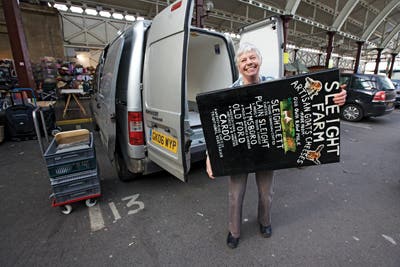
Direct to You
One of my favorite cheeses in the world is a petite round made with raw goats' milk called Cardo, which has a creamy, aromatic interior that oozes when sliced into. It's made about an hour's drive from my home in Somerset, England, at a place called Sleight Farm, a collection of stone buildings and hillside pastures that looks down onto a plateau of fields that stretch out until they touch the city of Bath. On a clear day you can look across the valley and see it as it must have been for hundreds of years: a few isolated houses and farms dotting a bucolic landscape. Mary Holbrook, Sleight Farm's owner, milks her own cream- and chestnut-colored goats and turns their milk into Cardo and four other kinds of cheese.
I've come to visit Holbrook on market day, the one day each week when she leaves her milking and cheese-making duties behind and drives eight miles to the Bath Farmers Market to sell her cheese. Ever since I first tasted her luscious Cardo, I've wanted to understand the journey involved in bringing such a beautiful, delicious, joy-inducing ingredient to market—the consideration, the planning, the obstacles, and the physical and mental work leading up to the days when the producer parts with her lovingly made cheese.
Small-scale artisan cheese makers have in recent years become pillars of farmers' markets in England, France, America, and beyond. Really, though, what people like Mary Holbrook do—making foods by hand, often from raw ingredients they've raised or harvested themselves, and selling them directly to customers—has always been part and parcel of market life. In many cases these small producers sell only at markets within a few hours' drive of their home. Cheeses like Holbrook's are too perishable to send much farther afield; and so, they've become the pride of their region, their flavors inextricably tied to the place. They are foods that tell a story.
Holbrook's story is similar to ones you'll hear in many industrialized parts of the world where people are embracing older, more hands-on ways of raising and producing food. Until the late 1970s, Holbrook was a curator at the Holburne Museum of Art in Bath; then she quit her job and took over a small farm that had been in her husband's family for years. "I started out with two goats," she says, "and I learned to make soft cheeses from their milk by reading books." She traveled to France to learn more and later became inspired by other European cheese-making traditions as well. Around the same time, Neal's Yard Dairy, the famous cheesemonger's shop in London, was beginning to sell cheeses made by hand on small farms like Mary's throughout the British Isles. England may be best known for its traditional cows' milk cheeses like cheddar and Cheshire, but Mary's cheeses helped to pave the way for an English cheese-making renaissance that introduced new goats' milk varieties like the creamy Ticklemore, made in Devon, as well as sheep's milk cheeses like the mild, nutty Spenwood from Berkshire. A number of traditional English cow's milk styles were rescued from extinction, too. Holbrooke's cheeses have long been popular at Neal's Yard Dairy, but when the UK's first farmers' market opened in Bath in 1997, Mary started selling there as well.
Market day starts at 7 a.m., when Holbrook, a slight woman with short gray hair, removes a few crates of cheese from the refrigerator and assesses which ones are ripe enough, supple enough, and have the right intensity of fragrance and flavor to be ready to sell. There are certainly sturdier cheeses than the ones Holbrook makes—products that can be sealed in airtight plastic and shipped to stores three time zones away. But Holbrook's cheeses need to breathe to ripen, and she tends to them constantly over the course of their aging cycle, which can range from three weeks to eight months.
We drive the 20 minutes to market down narrow country lanes, to the outskirts of the city, where the market takes place. A folding table comes out of the van, the Sleight Farm sign goes up, and by 8.30 a.m. Mary has set out her cheeses for sale. Throughout the morning, Holbrook's customers linger, inspect, taste, buy. They talk, too, asking about new cheeses, critiquing or complimenting the ones they bought a couple of weeks ago. "I like the direct contact with people." Holbrook says. "They tell me if one is too salty, or not salty enough." It's such a simple concept: buying food from the person who made it. And while it's hardly a novelty in countries or regions where an agrarian lifestyle has prevailed for a long time, it's a newfound pleasure for so many of us: members of the second or even third generation to be raised on supermarket shopping.
By 1:15, Holbrook folds up the table and packs the truck again so that she can be back at the farm by 2:00 to resume caring for her animals and her cheeses. She'll take back with her any cheese that hasn't sold, to go into the fridge or give away, depending on its condition. In the meantime, her customers will eat what she's made; they'll share it with friends, and tell those friends where it came from. —Tamasin Day-Lewis, the author of Supper for a Song_ (Quadrille, 2009)_
Keep Reading
Continue to Next Story










